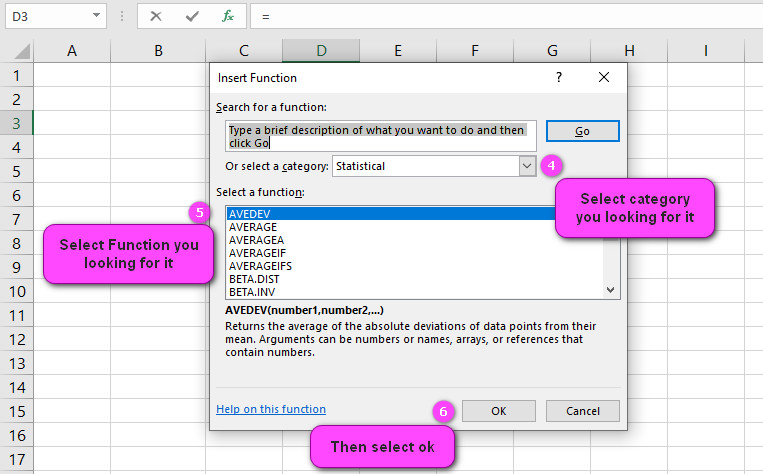What is GAMMA function in Excel?
The GAMMA function is one of the Statistical functions of Excel.
It returns the Gamma function value.
We can find this function in Statistical category of insert function Tab.
How to use GAMMA function in excel
- Click on an empty cell (like F5).

2. Click on the fx icon (or press shift+F3).

3. In the insert function tab you will see all functions.
4. Select STATISTICAL category.
5. Select GAMMA function.
6. Then select ok.

7. In the function arguments Tab you will see GAMMA function.
8. X is the value for which you want to calculate Gamma.
9. You will see the results in the formula result section.
Examples of GAMMA function in Excel
here are 10 examples of the GAMMA function in Excel:
- =GAMMA(2) – Returns the value of the gamma function for the number 2.
- =GAMMA(0.5) – Returns the value of the gamma function for the number 0.5.
- =GAMMA(-1) – Returns an error because the gamma function is undefined for negative integers and zero.
- =GAMMA(3.7) – Returns the value of the gamma function for the number 3.7.
- =GAMMA(5)– Returns the value of the gamma function for the number 5.
- =GAMMA(B2) – Returns the value of the gamma function for the number in cell B2.
- =GAMMA(A2)*GAMMA(B2) – Returns the product of the gamma function values for the numbers in cells A2 and B2.
- =GAMMA(PI()) – Returns the value of the gamma function for pi.
- =GAMMA(1/3) – Returns the value of the gamma function for one-third.
- =GAMMA(10^6) – Returns the value of the gamma function for one million.
What is the GAMMA function in Excel?
The GAMMA function is a mathematical function in Excel that calculates the gamma function value for a given number.
The gamma function is a generalization of the factorial function, which is defined only for positive integers.
The gamma function extends the domain of the factorial function to include non-integer and negative numbers as well.
How do I use the GAMMA function in Excel?
To use the GAMMA function in Excel, you simply enter “=GAMMA(number)” into a cell or a formula, where “number” is the argument for which you want to calculate the gamma function value.
For example, if you want to calculate the gamma function value for 4, you would type “=GAMMA(4)” into a cell or formula, and Excel would return the result of 6.
What is the syntax for the GAMMA function?
The syntax for the GAMMA function in Excel is: =GAMMA(number) where “number” is the numerical argument for which you want to calculate the gamma function value.
What arguments does the GAMMA function take?
The GAMMA function takes one argument: “number”. This argument can be any positive or negative real number, except for negative integers or zero. If “number” is a positive integer, the GAMMA function returns the value of (number – 1) factorial.
Can the GAMMA function be used to calculate factorial values?
Yes, the GAMMA function can be used to calculate factorial values. In fact, the gamma function is often used as an extension of the factorial function, as it allows for calculations of factorials with non-integer values.
For example, the factorial of 5 can be calculated using the GAMMA function as follows: =GAMMA(6) which returns the value of 120, which is equivalent to 5 factorial.
Can negative numbers be used as arguments in the GAMMA function?
Yes, negative numbers can be used as arguments in the GAMMA function. However, for non-integer negative numbers, the gamma function returns a complex number as the result.
For example, the GAMMA function of -1.5 is: =GAMMA(-1.5) and it returns the value of 2.36327180120735+3.93752169057795i, which is a complex number.
How accurate are the results from the GAMMA function in Excel?
The results from the GAMMA function in Excel are generally accurate up to 15 digits of precision.
However, like any mathematical function, there may be some rounding errors or inaccuracies in certain cases.
In general, the GAMMA function provides reliable and accurate results for most practical applications.
Can the GAMMA function be used with other functions in Excel?
Yes, the GAMMA function can be used with other functions in Excel, just like any other mathematical function.
For example, you could use the SUM function along with the GAMMA function to calculate the sum of gamma function values for a range of cells.
Here’s an example formula: =SUM(GAMMA(A1:A10)) This formula calculates the gamma function value for each value in cells A1 through A10, and then adds up all of the resulting values.
Are there any alternatives to the GAMMA function in Excel?
Yes, there are alternative ways to calculate gamma function values in Excel.
For example, you could use the BETA.DIST function, which is related to the gamma function. This function calculates the cumulative distribution function of a beta distribution, which can be expressed in terms of the gamma function.
Alternatively, you could use the incomplete gamma function (GAMMAINV), which is another function that is closely related to the gamma function.
Can the GAMMA function be used in macros or VBA scripts?
Yes, the GAMMA function can be used in macros or VBA scripts just like any other Excel function. You would simply use the worksheet function syntax (e.g. “=GAMMA(number)”) within your VBA code.
Here’s an example macro: Sub GammaFunctionExample() Dim result As Double result = WorksheetFunction.
Gamma(4) MsgBox “The gamma function value for 4 is: ” & result End Sub This macro calculates the gamma function value for 4 using the GAMMA function and displays the result in a message box.


